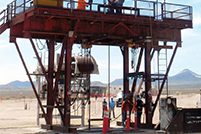The Department of Energy’s National Nuclear Security Administration (DOE/NNSA) recently completed the first underground, chemical explosion in the second phase of the Source Physics Experiment (SPE), which is designed to advance the United States’ ability to detect underground nuclear explosions.
The SPE is a multiphase campaign using buried explosives to generate seismic and acoustic signatures similar to those emitted by an underground nuclear detonation.
“The data collected from the SPE trials strengthen our national security by advancing technical solutions for treaty monitoring and improving computer simulation methods used to evaluate potential explosions anywhere in the world,” said Dr. Brent K. Park, NNSA’s Deputy Administrator for Defense Nuclear Nonproliferation.
Research teams from Nevada National Security Site, Los Alamos National Laboratory, Lawrence Livermore National Laboratory, Sandia National Laboratories, and the University of Nevada-Reno collected information and measured the unique signatures generated by this experiment. Scientists used high-resolution accelerometers, seismometers, infrasound sensors, and high-speed video to collect data.
This second phase of the SPE campaign is expected to conclude by May 2019. A total of four experiments are planned as part of this phase. Seismic data collected from the SPE experiments are made available to researchers around the globe for analysis via the Incorporated Research Institutions for Seismology website at http://www.iris.edu/hq/.

